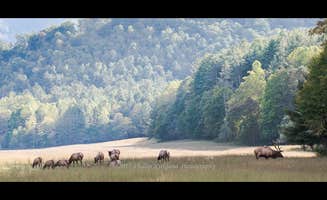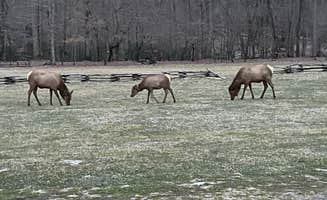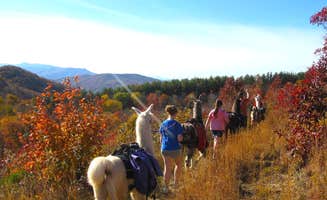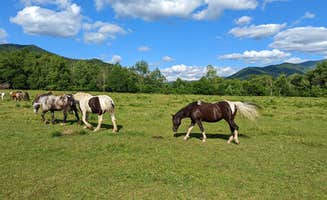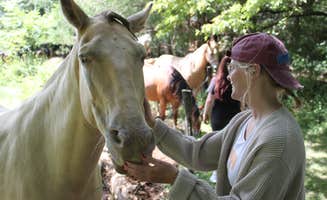Equestrian campers find several options within the Cosby, Tennessee region, where the landscape transitions from 1,700 feet elevation at Big Creek to higher mountain terrain at surrounding backcountry sites. Trail riders access both national park and national forest lands without traveling far from base camps. Camping facilities range from primitive sites with limited vehicle access to horse-designated areas with space for multiple trailers.
What to do
Observe elk herds: Cataloochee Valley offers excellent wildlife viewing opportunities for equestrians and other visitors. "If you want to see the elk, you're going to have to be up early. I use to be in the park at 5 AM with night vision gear, I saw some very nice elk. If you go in the winter, the elk are out eating most of the day," notes Patrick K. about Cataloochee Campground.
Explore historic structures: The area contains preserved buildings that showcase mountain history. "There are historical homesteads, a school, churches and cemetery to take you back in time. Trails by creeks there to hike. Bears, turkeys, deer and the Elk," explains Jodie K. about Cataloochee.
Cool off in mountain streams: Natural swimming areas provide relief for horses and riders. "The falls were beautiful, and jumping into Midnight Hole was fun. Even at midnight," shares Chris M. about Big Creek Campground.
Ride connecting trails: Multiple trail systems intersect near camping areas. "Since this campground is located in a national park. If you like hiking, there are miles of hiking trails," mentions Myron C. about Cataloochee, with similar trail access available at other equestrian sites.
What campers like
Creek-side camping spots: Riverside sites provide natural sounds and cooling effects. "We camped near the creek and it was beautiful. Also viewing the elk is an experience I will never forget," says Mike G. about Tricorner Knob Shelter, which serves as a high-elevation stopping point for riders.
Quiet atmosphere: Many equestrian camps maintain distance from busy tourist areas. "A small campground, and u need reservations, early, to see the Elk rutting in early October. It's a long 13 miles into the valley down a very narrow, curvy gravel road," explains Jodie K., highlighting the remoteness that keeps crowds minimal.
Forest diversity: The varied terrain offers multiple ecosystems to explore. "This campground is one for making memories and enjoying truly the outdoors. Hiking trails depart from this campground and lead to some of the most historic areas of the great Smoky Mountain National Park," notes Crystal C. about Cataloochee.
Limited cellular service: The disconnection from technology creates a more immersive experience. "We had to work and do school while there and the Verizon cell service was limited and the WiFi signal was not great at our rig," reports John about Townsend-Great Smokies KOA, which is consistent with most rural camping areas near Cosby.
What you should know
Road conditions require preparation: Access roads to horse camps often present challenges. "I would recommend a 4x4 high clearance vehicle. A short wheelbase van would probably be ok," advises Timothy about Harmon Den Area, adding "The forest road is not compatible with big rigs, RV's, or travel trailers."
Wildlife considerations: Both bears and elk require respectful distance. "Be careful out there though, a black bear walked through our site while we were fixing dinner. Didn't bother us, but it was a nice little scare," shares Chelsie A. about Tricorner Knob Shelter.
Water sources vary: Natural water availability differs by location and season. "Water source was very close to the shelter. We had zero issues with bugs or critters bothering us at night," reports Christina Z. about high-country shelters.
Advance planning essential: Reservations fill quickly for limited equestrian sites. "This site is so peaceful and gorgeous. The wildlife is all around you and they aren't scared to interact, though you shouldn't encourage them," mentions Chelsie A.
Tips for camping with families
Select less remote sites: Families with young children benefit from more accessible locations. "The campground has several trailheads for hiking in the Smokies. A very nice feature is how close the campsites are to the creek. It was great for the dogs to cool off," explains Katrin M. about Cades Cove Campground.
Plan for weather changes: Mountain elevations experience temperature fluctuations. "The area around the shelter is high, rocky, and remote. Expect 10-15 degrees less than the Park headquarters," advises Bill S. about backcountry options.
Consider tent size requirements: Site dimensions affect equipment choices. "Each site was large enough to spread out in with a small camper or a tent. Tent pads are large and size allowing for even the largest of tents," notes Crystal C.
Evaluate bathroom facilities: Sanitation options vary significantly between locations. "Bathrooms we're fairly well kept. There are no showers. For running water you can use water spigots that are around the campground," says Katrin M.
Tips from RVers
Measure trailer length carefully: Size restrictions limit which horse trailers can access certain sites. "There's one that goes from Big Creek Campground to Cataloochee. I would recommend this one because of how scenic it is, but we once got stuck behind a tractor trailer on the small gravel road and had to sit there for an hour in order to get going again," cautions Kristina about access routes.
Confirm turning radius requirements: Forest roads often have tight curves unsuitable for longer rigs. "Though many campsites will accommodate large rigs, motorhomes over 32' and trailers over 25' in length are not recommended due to the access road," Kristina notes about Cataloochee.
Check road closures seasonally: Winter conditions may affect accessibility. "This campground is frequently effected by weather so planning in advance is a must!" warns Crystal C.


